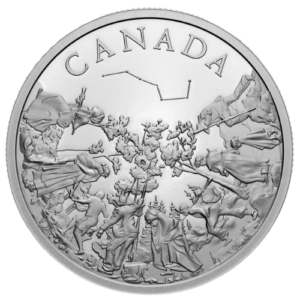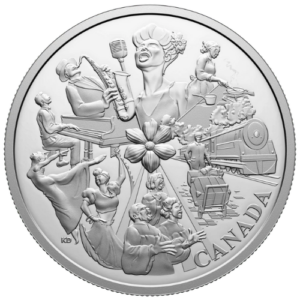Last updated on February 20th, 2025 at 08:34 am
Last Updated on February 20, 2025 Posted by Colonial Acres Coins
Black History Month, observed every February in Canada and the United States, is a time to celebrate the remarkable achievements and invaluable contributions of Black communities throughout history. It also serves as a moment to reflect on the ongoing pursuit of equality and justice. This month is more than just a tribute—it’s a call to remember, learn, and honour the triumphs and struggles that have shaped the history we share.
The Royal Canadian Mint (RCM) has embraced this spirit of recognition and remembrance by releasing a series of commemorative coins over the years in honour of Black History Month. These coins go beyond their monetary value, serving as tangible pieces of history that preserve and share the stories of Black leaders, pivotal events, and cultural legacies that deserve to be celebrated and remembered.
From heroic tales of the Underground Railroad to tributes to trailblazing figures who redefined Canada’s history, each design is a thoughtfully crafted tribute to courage, resilience, and community.
Through these coins, the RCM captures essential chapters of Black history, ensuring they are not only remembered but also appreciated by future generations. These tributes remind us of the importance of acknowledging where we’ve been, so we can better shape where we are going.
What makes these coins especially meaningful is the way they invite us to learn—each one tells a story, offering a moment to reflect on the individuals and movements that brought about change and inspired progress.
These commemorative pieces are more than collectibles. They are an enduring celebration of the courage, strength, and contributions of Black Canadians, whose stories inform the cultural fabric of the nation.
Keep reading as we explore the details behind these remarkable coins and the history they honour.
The 2022 $20 Underground Railroad Silver Coin
The 2022 $20 Underground Railroad silver coin is a beautiful and meaningful tribute to this important period in history. Designed by Canadian artist Kwame Delfish, the coin’s reverse side tells a powerful story through its intricate imagery.
Key features of the coin’s design include:
- Men, women, and children are placed along the coin’s edge, creating a sense of circular motion to represent the long journey to freedom
- Tall trees and rocky terrain, symbolize the challenging wilderness that escapees had to navigate
- The Big Dipper constellation is prominently displayed in the night sky, representing the crucial guidance it provided to those travelling north
- The word “CANADA” is engraved as part of the design, signifying the destination and promise of freedom

The Underground Railroad: A Path to Freedom
The Underground Railroad was not an actual railroad, but rather a network of secret routes and safe houses used by enslaved African Americans to escape to free states and Canada in the 19th century. This clandestine system played a crucial role in helping thousands of individuals find freedom and safety.
Key aspects of the Underground Railroad include:
- A network of abolitionists, free Black people, and other activists who provided support
- Secret routes and hiding places that stretched from the southern United States to the northern states and Canada
- Code words and symbols used to communicate and maintain secrecy
- Brave “conductors” who guided escapees along the route
To avoid detection and ensure the safety of those involved, the Underground Railroad used railroad terminology as code. For example:
- “Stockholders” were financial supporters
- “Conductors” guided escapees along the route
- “Passengers” or “cargo” referred to the enslaved individuals seeking freedom
- “Stations” or “depots” were safe houses where escapees could rest and hide
One of the most important tools for those travelling the Underground Railroad was the Big Dipper constellation, also known as the “drinking gourd.” This celestial formation pointed to the North Star, providing crucial guidance for those journeying northward under the cover of darkness.
Why Canada?
Canada became a popular destination for those escaping slavery for several reasons:
- The Slavery Abolition Act of 1833, which came into effect on August 1, 1834, abolished slavery across most of the British Empire, including present-day Canada.
- Canada was viewed as a safe haven, offering freedom and the opportunity for a new life.
- The country’s proximity to the northern United States made it an achievable destination for many escapees.
While Canada provided freedom from slavery, it’s important to note that equality was not guaranteed, and many Black individuals still faced discrimination upon arrival. Nevertheless, the prospect of freedom made Canada an attractive terminus for those travelling the “Freedom Train.”
A New Coin Design Release for 2025!
Building on the success of previous Black History Month coins, the Royal Canadian Mint has released a new commemorative piece for 2025: the $20 Hogan’s Alley Fine Silver Coin. This coin pays tribute to a significant Black community that once thrived in Vancouver, British Columbia.

What is the Significance of Hogan’s Alley?
Hogan’s Alley holds a vital place in the history of Vancouver as the city’s first Black community and a vibrant hub of culture and resilience in the early 20th century. It was home to Black workers, activists, and creatives who left an indelible mark on the city’s cultural and social fabric.
Many of the community’s residents were Black railway porters who, through their union efforts, became integral in advancing labour rights for Black Canadians. Women also played a key role in shaping Hogan’s Alley, establishing themselves as organizational leaders and entrepreneurs. Their restaurants and speakeasies not only became beloved local institutions but also positioned the area as a thriving cultural center.
Among the notable figures from Hogan’s Alley was Nora Hendrix, grandmother of legendary guitarist Jimi Hendrix. An influential resident, she co-founded Vancouver’s first Black church, the African Methodist Episcopal (AME) Fountain Chapel, in 1918. Her contributions extended beyond the spiritual, as she also worked in some of the community’s most iconic establishments, like Vie’s Chicken and Steak House—a hotspot visited by both locals and celebrities.
Despite its contributions, Hogan’s Alley faced a devastating fate in the 1960s, when the city demolished the community as part of an urban renewal project. This decision displaced its residents, erasing a flourishing cultural mosaic that had made the area extraordinary. The effects of this displacement continue to resonate, marking a painful chapter in Canada’s urban history.
The coin’s reverse design by Kwame Delfish beautifully captures the spirit of the community, featuring:
- The Pacific Dogwood: British Columbia’s provincial flower at the center of the design.
- A woman cooking: Representing the famed chicken house restaurants of Hogan’s Alley.
- A Black railway porter: Symbolizing the community’s strong working-class roots.
- A choir: Depicting the AME Fountain Chapel and its important role in the community.
- Dancers, musicians, and singers: Celebrating the neighbourhood’s rich cultural and artistic legacy.
Although Hogan’s Alley no longer exists as it once did, its history and contributions remain a testament to the resilience and creativity of its residents. This coin helps keep its story alive, inviting collectors to honour and preserve the memory of Vancouver’s first Black community for generations to come.
Preserving History Through Numismatic Art

These collectable coins are tangible reminders of the struggles, triumphs, and enduring legacy of Black Canadians offering an opportunity to reflect on our shared history and the ongoing journey towards equality and justice.
Check out these past blog posts to learn more about these Royal Canadian Mint coins released in honour of Black History.
- No. 2 Construction Battalion Coin released in 2023
- Amber Valley $20 coin released in 2024 check out our blog.
As we celebrate Black History Month, consider adding these meaningful pieces to your collection. Not only will you own a beautifully crafted coin, but you’ll also be preserving an important part of our collective history.
Visit Colonial Acres Coins today to purchase your commemorative coin and join in honouring the rich tapestry of Black Canadian history.
FAQ’s
How does the 2022 $20 Underground Railroad Silver Coin represent this historical event?
The coin represents the Underground Railroad through imagery of people travelling along its edge, challenging terrain, the Big Dipper constellation, and the word "CANADA." These elements symbolize the journey to freedom, obstacles faced, guidance provided, and the ultimate destination.
What was Hogan's Alley, and why is it important to Canadian Black history?
Hogan's Alley was Vancouver's first Black community, thriving from the early 1900s to the 1970s. It was a vibrant cultural hub, home to many Black railway porters and entrepreneurs. Its importance lies in its role in shaping Vancouver's cultural landscape and providing a space for Black Canadians to build lives and businesses.
How does the 2025 $20 Hogan's Alley Fine Silver Coin commemorate this community?
The coin commemorates Hogan's Alley through images representing various aspects of community life, including residents, the first Black church, and cultural activities. It celebrates the community's entrepreneurial spirit and cultural contributions, serving as a lasting tribute to this significant piece of Canadian Black history.
Why are these commemorative coins important, and how do they contribute to Black History Month?
These coins are important because they raise awareness about significant events and communities in Canadian Black history. They provide educational opportunities, support the preservation of cultural narratives, and encourage reflection on issues of equality and diversity. During Black History Month, they serve as reminders of the struggles and triumphs of Black Canadians.




